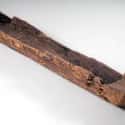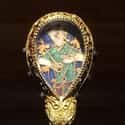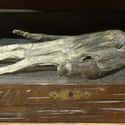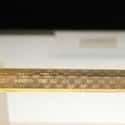-
(#7) The Pesse Canoe (c. 8000 BC)
Believed to be the oldest-known boat in the world, and certainly the oldest canoe in the historical record, the Pesse canoe was discovered in Pesse, a village in the Dutch province of Drenthe, during the construction of a highway. The boat was carved out of a pine log roughly 10,000 years ago.
Carbon dating has placed the canoe's construction to the Mesolithic period, between 8040 BC and 7510 BC. A similar boat was discovered outside a village in Nigeria, dated some 2,000 years later.
-
(#9) The Alfred Jewel (c. Ninth Century AD)
Discovered in a field in Somerset, England, in 1693, this royal relic dates to the reign of King Alfred the Great (871-899 AD) and bears the inscription "AELFRED MEC HEHT GEWYRCAN," or "Alfred ordered me to be made."
According to the Ashmolean Museum, the jewel was originally part of an aestel, or pointer, a device used to follow text in manuscripts. A "significant" piece of Anglo-Saxon goldsmithing, the aestel was crafted around a slice of rock crystal.
-
(#14) The Whitby Museum's Hand Of Glory (c. 18th Century AD)
The Whitby Museum's Hand of Glory is not especially ancient, but it is a well-preserved example of an occult practice that dates back centuries (allegedly, it is also the only such hand to survive to the present day). The museum has a great, if gruesome, explanation of how these hands were purportedly used:
A Hand of Glory was supposedly the carefully prepared and "pickled" right hand of a felon, cut off while the body still hung from the gallows and used by burglars to send sleepers in a house into a [deep unconsciousness] from which they were unable to wake. In one version the clenched hand is used as a candleholder for a candle incorporating human fat, but in another (consistent with the Whitby hand) the outstretched hand has its own fingers lit. In this case should one of the fingers refuse to light it is a sign that someone in the household remains awake.
This hand was discovered in the early 1900s on the wall of a cottage in Castleton, England.
-
(#10) British Museum Royal Game of Ur (c. 2600-2400 BC)
Popular throughout the Mediterranean and the Middle East thousands of years ago, the Royal Game of Ur was a popular pastime for ancient peoples.
As Irving Finkel, the assistant keeper at London's British Museum in the Department of the Middle East, explains, "There were no entertainments for such a huge period of human existence. In that environment, games had a fantastically strong hold. They reigned supreme."
Time sums it up even better: "For centuries, even millenniums, the Royal Game of Ur served as the PlayStation of its day."
-
(#13) The First Gutenberg Bible To Arrive In The United States (c. 15th Century)
One of the earliest mass-printed books, the Gutenberg Bible is a landmark in the history of humankind - and literacy in general. Of the 180 original Bibles, some 49 still exist today, 10 of which may be found in the United States.
The Bible pictured here, now on display at the New York Public Library, was bought by James Lenox in 1847. It was the first copy purchased by a US citizen.
-
(#6) Sword Of Goujian (c. 771-403 BC)
Despite being more than 2,500 years old, this Chinese dagger still retains a cutting edge. It was discovered in a tomb in Hubei, China, in 1965, and is believed to date back to the era between 771 and 403 BC. Forged from copper and tin, the blade also contains blue crystals and turquoise.
The Metropolitan Museum of Art notes that the eight characters engraved on the blade are an ancient writing called "bird-worm seal script," which reads, "King of Yue... made this sword for [his] personal use."
New Random Displays Display All By Ranking
About This Tool
While ancient times happened so long ago, some things never change. Over the years, archaeologists from all over the world have devoted themselves to excavating and exploring the history of human civilization. They have unearthed many valuable ancient cultural artifacts in a wide range, including tools, pottery, metal objects, personal items, etc. Cultural relics are relics and relics that reflect the material and spiritual culture of a nation.
The random tool shows 15 amazing artifacts from ancient times that reflect social development and social life from different aspects, and they are physical materials for studying the history of the ancient world.
Our data comes from Ranker, If you want to participate in the ranking of items displayed on this page, please click here.
















